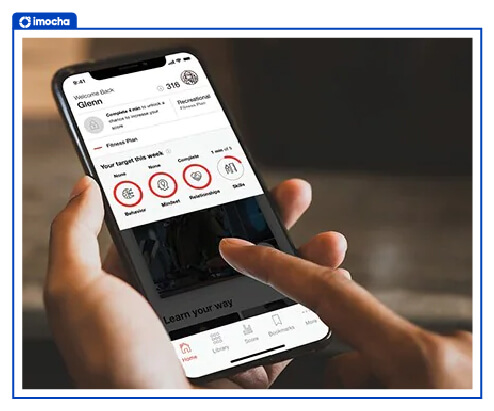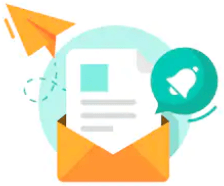Is there a recipe for success for creating a learning and development strategy? In this section, we will talk about what it takes to create a holistic learning and development strategy framework.
-
Aligning with the business strategy:
To pave the way for a value-driven learning and development strategy in a modern organization, L&D executives should ensure that the L&D strategy
- aligns with the company's business goals as well as the talent strategies,
- assists in professional development,
- builds capabilities across the company, cost-effectively and promptly,
- improves the company's culture,
- encourages employees to embrace and live the company's values,
- supports the execution of the business strategy, and
- explicitly connects with the company's strategic objectives.
This can be done by analyzing the employees' existing capabilities and narrowing down on which skills are most critical to aid the execution of the company's business strategy. Ideally, L&D leaders must review the skills-goals alignment on a yearly basis. This will ensure that the people on the team are truly reflective of the company's latest priorities and strategic objectives.
-
Driving synergy and co-ownership between the HR and other business teams:
Without collaboration and synergy between teams, companies cannot hope to be agile. Whether the HR team wants to launch capability-building programs on the fly or whether they want to adapt to the changing business processes, a buy-in from all the teams is essential at every step of the company's learning and development strategy.
So how can L&D leaders drive greater partnerships between the teams and the business
leaders? Here are a few helpful tips:
-
Build a governance structure in which everyone, from the CXO to the business unit heads, shares
responsibility for defining, prioritizing, and executing L&D programs.
-
Drive active participation from senior executives to embed a culture of learning
across business initiatives and strategic goals.
-
Assessing capability gaps and demands for specific skills in the future:
Once the business goals and objectives are in place, the next step is to assess the
employee's existing capabilities to ensure that they can deliver on the goals outlined
and cater to the needs of the future. To that end, companies should focus on:
- Assessing capability gaps, particularly for senior leaders and mid-level managers
- Embracing an intentional and systematic approach to capability assessment
- Building a comprehensive capability model that is centered on the company's strategic direction
- Analyzing how employees fit into the overall goals
- Closing the capability-goal gap by designing a portfolio of initiatives
Use-Case: How PwC Singapore Catered to the Needs of a More Digital Tomorrow and Addressed the Skills Gap
To help employees upskill and stay relevant to the demands of the future, PwC Singapore undertook the following initiatives:
Step 1: The team identified the key skills that would be "relevant" for the digital future, such as data analytics skills, literacy skills, and visualization skills.
Step 2: With the role of automation increasing in monotonous day-to-day activities, the team encouraged employees to move to different roles that require more human and strategic skills (read: problem-solving, critical thinking, and effective communication).
Step 3: This radical shift was communicated to employees by the senior leaders. Moreover, the leaders "walked the talk" by adopting digital tools in their daily work.
Step 4: Communications were supplemented with a multichannel approach to drive internal awareness via events (think: town halls), regular newsletters, and emails. This helped address key issues and concerns in real-time.
Step 5: The firm embraced a robust learning toolkit to hone employee skills, which included the following initiatives:
-
The company conducted internal training for soft skills and technical
knowledge—from business writing to regulatory updates.
-
It offered sponsorships and co-funding opportunities for employees who wanted to attend relevant courses as approved by SkillsFuture Singapore.
-
To supplement classroom learning, the company embraced on-the-go learning tools
such as "Vantage" and the Digital Fitness App (shown below):
 These tools provided employees with easy, on-demand access to learning materials.
For example, if an employee wants to advance their skills in data analytics, they
can simply search for the available resources and watch/listen to/read it at their
own pace and convenience.
These tools provided employees with easy, on-demand access to learning materials.
For example, if an employee wants to advance their skills in data analytics, they
can simply search for the available resources and watch/listen to/read it at their
own pace and convenience.
-
Creating tailored learning journeys and delivering plans for specific roles:
Effective and immersive corporate learning comprises two key components:
in-person sessions and online learning formats. To take the L&D program to the
next level, organizations should embrace a multichannel approach, with an
average of five formats
being considered ideal for employees. However,
executives struggle with numerous challenges when it comes to integrating an
L&D program within their schedule. Moreover, business leaders also fear that
the training outcome might stunt their career prospects.
To cater to these issues and ensure a culture of continuous learning, the L&D program should:
-
Accommodate the needs of the executives and ensure that learning occurs over a period of time, at the learner's convenience and preferred time
-
Narrow down on the learning infrastructure and enablers
-
Include interactive experiences such as fieldwork, social learning, on-the-job coaching,
workshops, and so on to guarantee better learning
- Ensure regular follow-ups by way of pre and post-classroom digital learning sessions
-
Identifying the roadblocks and scaling up execution
L&D leaders face numerous challenges when rolling out a sustainable and scalable
learning and development program. Here are the top-four obstacles to L&D as per a
Udemy report:

Here's how L&D leaders can deliver a holistic learning and development program that is ROI-driven, on-time, and under budget:
- Prioritizing the right initiatives can prevent initiative overload.
-
Driving honest ongoing discussions with business leaders can ensure that the requisite resources and support are available as needed.
- Driving a small pilot program, which is targeted at a limited audience, can ensure that the program is successful when rolled out enterprise-wide.
-
Ultimately, launching a skilling hub comprising capability programs that address the need for
critical skills and are solely dedicated to learning and development.
-
Measuring impact of business performance:
Not understanding what is working (and not working) for the learning and development
program can be counter-productive. To ensure that the program is headed in the right
direction, the L&D team in charge should:
-
Measure the program efficacy against key performance indicators (KPIs) such as:
Business-excellence: Understanding how closely aligned all L&D initiatives are with the company's
priorities
Learning-excellence: Analyzing whether the learning initiatives are bringing about a change
in people's behavior and performance
- Operational-excellence: Reviewing how well the investments and resources are
being used
- Use outcomes-based metrics as opposed to the traditional metrics to understand the impact on employee performance, engagement, etc.
- Analyze how the learning strategy can assist in the organization's priorities and strengthen the health of the enterprise.
- Review whether the learning program can build the required mindset, skills, and expertise of employees and achieve maximum impact.
- Assess the employee's capability gap against a comprehensive capability framework.
- Ensure that the team has access to big data at all times to drive data-driven decision-making.
-
Marrying L&D initiatives with HR:The L&D corporate learning initiatives should be
integrated with the business objectives and the HR agenda. In fact, numerous L&D initiatives
actually overlap with HR goals such as performance management, succession planning, onboarding, etc.
To make the most out of company learning and development strategy initiatives, L&D leaders
should:
-
Connect the initiatives with annual performance reviews and drive consistent, in-the-moment feedback follow-ups and feedback processes.
- Understand the core HR management practices and processes, and collaborate with HR leaders.
- Leverage consolidated development feedback and use it as ammunition for advancing the capability-building agenda.
- Build a high-impact onboarding process to drive greater employee engagement and satisfaction.
-
Enabling a "70:20:10" learning framework:
The "70:20:10" signifies the following: 70% of learning occurs on the job, 20% occurs via
interaction and collaboration, and 10% occurs using formal-learning interventions
(read: classroom training and digital curricula). To implement an effective and all-round
system of learning, organizations should support informal learning with other areas of
learning and development such as:
- Coaching and mentoring
- On-the-job instruction
- Apprenticeships and leadership shadowing
- Action-based learning
- On-demand access to digital learning
- Lunch-and-learn sessions
- Social learning formats
-
Embracing technology for enabling just-in-time learning:
To enable just-in-time learning, organizations need to invest in cloud-based
learning- technology platforms and applications. These include:
- Next-generation learning management systems
- Virtual classrooms
- Mobile-learning apps
- Embedded performance-support systems
- Polling software
- Learning-video platforms
- Learning-assessment and measurement platforms
- Massive open online courses (MOOCs)
- Small private online courses (SPOCs)
By leveraging these plug-and-unplug systems, L&D leaders can lay the foundation for a scalable and cost-effective learning model with technology at its heart. The right cocktail of tools can assist in core areas of HR development such as recruitment, onboarding, performance management, real-time feedback, succession planning, career management, and rewards and recognition.




 These tools provided employees with easy, on-demand access to learning materials.
For example, if an employee wants to advance their skills in data analytics, they
can simply search for the available resources and watch/listen to/read it at their
own pace and convenience.
These tools provided employees with easy, on-demand access to learning materials.
For example, if an employee wants to advance their skills in data analytics, they
can simply search for the available resources and watch/listen to/read it at their
own pace and convenience.


